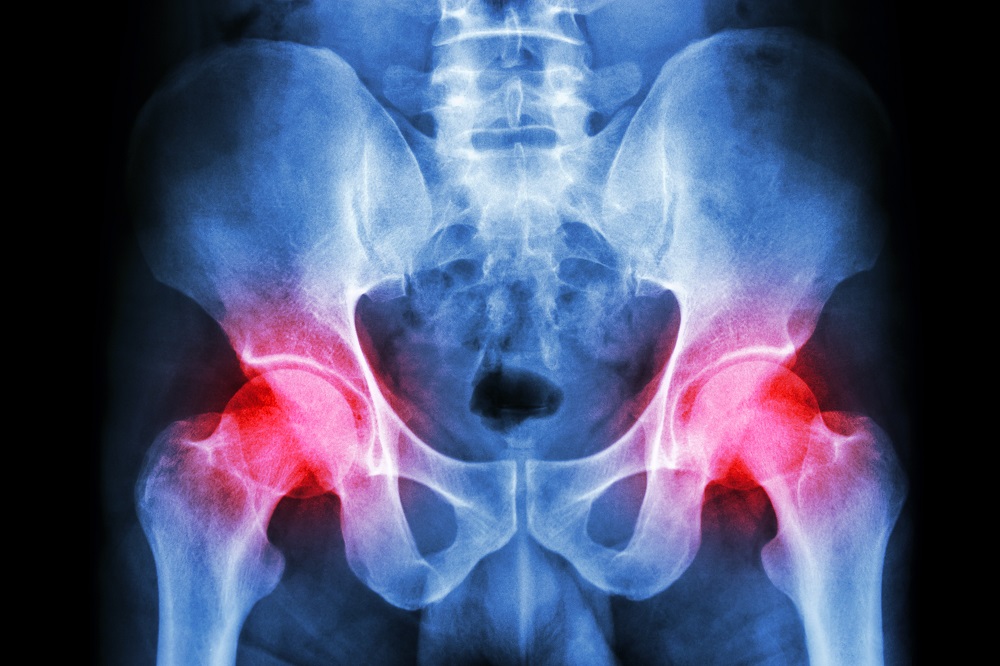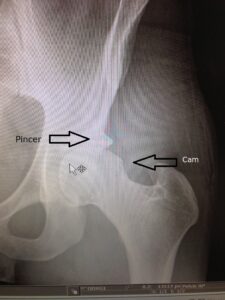Pinching Pain In The Front of The Hip: My Story of FAI

The Pinching Pain
Have you ever experienced a pinching pain in the front of your hip? This generally occurs during activities of hip flexion such as squatting, sitting, jumping, lunging, or certain yoga poses. The pinching pain can either feel sharp or may even feel like a dull ache, especially with prolonged sitting. If you have experienced this type of pain, perhaps you’ve also noticed that you have trouble sitting in certain positions. Maybe your hip gets really tight after a long car ride or from sitting at the office all day. Pinching pain in the front of the hip could be many different things. In my case, it is due to femoral acetabular impingment (FAI)
What is FAI?
FAI is a fancy term for pinching in the front of your hip. The hip joint is a ball in socket joint. Unlike the shoulder, this joint is very congruent and the ball fits nicely in the socket. There is not much space between the two joint surfaces. Certain stresses placed on the joint can lead to the development of small bone spurs. FAI occurs when these areas of excess bone growth are beginning to limit mobility. There are three types of FAI:
- Cam Lesion: This occurs when a bone spur develops on the head of the femur (the ball portion of the joint). This area of extra bone growth has now made the ball slightly larger, which in turn limits the joint’s ability to move in certain directions. As you can imagine, the two joint surfaces begin to approximate, leading to pinching pain in the front of your hip.
- Pincer Lesion: Instead of developing a bone spur on the femur, it is also possible to develop a bone spur on the acetabulum (the socket portion of the joint). Most commonly, excess bone is formed on the overhanging portion of the socket. This has a very similar effect as the cam lesion and can lead to pinching pain in the front of your hip.
- Mixed: The name says it all. A mixed lesion FAI occurs when a person has developed bone spurs on both the femur and acetabulum (cam and pincer lesions). This is exactly what I have.
My Story
This is an actual radiograph of my left hip. Sorry for the poor quality, it was taken with an iPhone from the computer screen in the x-ray tech’s office.
The pinching pain in the front of my hip started during my last year of undergrad. At that time, it was very mild and it may have even been a stretch to call it “pinching pain.” It was more of an occasional ache that only occurred when I did heavy squats in the gym. It didn’t bother me with any other activities so I didn’t really think much of it. Like most people do with minor aches and pains, I chose to ignore it.
About a year later when I started physical therapy school down in San Diego, I started to noticed this pain becoming worse. It was increasing both in frequency and intensity. Again, it wasn’t to the point where it was really interfering with my life so I ignored it. However, that was no longer so easy to do. Being in physical therapy school, I was hyper-aware of everything about my body because that what we were learning about all day everyday. Additionally, having 30+ hours per week of in-class time also meant more sitting. I was sitting for most of the day with my hips in 80-90 degrees of flexion (not a good position for FAI). I attributed the increasing pinching pain to more time sitting and again, didn’t do anything about it.
Later into my first year of physical therapy school, it was getting to the point where I could barely sit through lecture without constant aching pain. I even started to build my own standing desk at the back on the class so that I could make it through lecture without being constantly reminded on my hip pain. I finally decided to do something about my hip pain.
One of my professors at the time, Chris Ingstad, was completing a fellowship program and looking for patients to work with. He offered to treat me so I gladly took the opportunity to get my problem addressed. After the initial evaluation, he suggested that I likely have FAI, which was later confirmed through radiography (x-ray imaging). I also have a labral tear in that hip because I ignored it so long and the bone spurs eventually wore down on my labrum, causing it to tear. He treated me for about 6 sessions, during which time we made some great improvements. Now, keep in mind that FAI is a structural condition. This means that it is something that is not going to be eliminated through conservative management because the bone spurs have already developed. However, it can still be managed and symptoms can still be significantly decreased.
I made some excellent progress and although my pain was not eliminated, I learned some techniques to maintain my hip mobility and manage my own condition. Currently, I still have the cam and pincer lesion but through certain mobility drills, strengthening exercises, and activity modification, I have been able to maintain an active lifestyle that is not limited by pain. I continue to run, lift weights, and I just completed my first Olympic Triathlon last month.
Why Didn’t I Just Get Surgery?
You may be asking yourself why I didn’t just go get the bone spurs removed? Several reasons. First of all, any time you have an orthopedic surgery, you are increasing your chances for arthritis down the road. Secondly, hip arthroscopy surgeries are a relatively new procedure and the research on outcomes isn’t great. Often times, the outcomes with or without surgery are very similar. Many people get the bone spurs shaved off, yet they still have the same pain and functional limitations. That’s not always the case. There are some people who do really well after surgery. However, I believe that going under the knife is a last resort and should be reserved for situations in which the condition is so severe that it is truly interfering with your daily life. Many people don’t realize how powerful conservative management can be. The quick fix is not always the best option when you are thinking long-term.
What You Can Do
If you ever experience pinching pain in the front of your hip, I highly suggest you get it checked out by your physical therapist early on. You don’t want to wait until it gets worse because if you catch FAI earlier, you can prevent it from getting worse and further limiting your mobility and function. Don’t do what I did and ignore it because then you run the risk of also developing a labral tear. There are ways that you can decrease the pain and improve your mobility through physical therapy intervention. Your physical therapist can educate you on how to manage FAI and prevent it from worsening. If you know someone dealing with pinching pain in the front of their hip, do them a favor and share this article with them. The sooner you get in to see your physical therapist, the better outcome you’re going to have.


